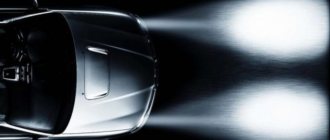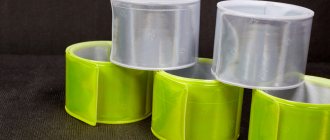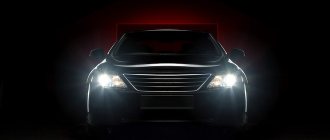Friends, we bring to your attention a very good article from the magazine BEHIND THE DRIVE (July 2018). Author Kirill Mileshkin, photo: Georgy Sadkov. Source: m.zr.ru
We are checking whether it is worth spending money on altering the headlights of a used car, the “vision” of which has been affected by age and mileage.
New light sources - xenon, LEDs, matrix technology - have brought automotive lighting to a fundamentally new level. But what good are the good intentions of an engineering genius if they simultaneously add problems to car owners? The plastic lenses of the headlights become cloudy, the lenses burn out - and after five years (and sometimes even earlier), the effectiveness of the headlights noticeably sags. At the age of seven years, some cars go completely “blind”, despite their sophisticated interior. So what should I do?
Glasses prescription
Medicines for the treatment of automobile vision are known: replacing lamps, restoring lenses, polishing lenses. All means simultaneously provide the maximum effect, but not everyone decides on such therapy, preferring to limit themselves to half measures. Replacing the headlight assembly is a solution for the strong-willed, because the prices for xenon and LED lighting equipment will make even people with solid incomes howl. Therefore, we decided to check what a compromise option that is gaining popularity provides - installing LED lens assemblies. This is noticeably cheaper than buying a pair of headlights.
No, no, we do not promote “collective farm” tuning, when xenon or LED lamps are installed in halogen optics! As our numerous tests have shown (ZR, No. 5, 2018), nothing good will come of this idea, and such tuning cannot be included within the framework of the law.
| Standard bi-xenon | Standard halogen |
| Standard Bi-LED | Bi-LED lenses Luma |
It's about something else. We tested Luma Bi-LED lenses that meet the requirements of UNECE Regulation 112-01, paragraph 6.2.4 “Measurement of low beam headlight illumination”.
Lens assemblies are relatively easy to implant into headlights. Manufacturers of tuning lenses adapt seats to standard elements. The module can also be integrated into reflective optics. It is now more correct to call the diffuser simply a protective cap, since in modern headlights it does not participate in the formation of the beam - the lens is responsible for this. So the biggest difficulty is to disconnect the diffuser from the body for work, since modern optics are made non-separable.
Installation of diodes
After reading a lot of information about LED lamps, I decided to install them in the lens instead of xenon. The only difficulty that arose during the installation process was that, despite the fact that the diode was the same size as the xenon lamp, I had to slightly increase the seating area of the lens.
The reason for this is this: the lens in the headlight is not standard, but is designed for a xenon lamp, the bulb of which is slightly narrower than the LED. The decision to purchase S7 diodes was due to the presence of a flexible cooling radiator. It can be conveniently located in the headlight housing. The installation did not cause any more difficulties. Everything fit inside the headlight and was connected to the standard wiring.
Convalescent ward
We spent a long time selecting a group of test cars for comparative tests at the test site. We settled on the popular Mazda CX-5 crossover - not only because it is in the top 25 of the market, but also based on information from alternative light installers: they claim that owners of cars of Japanese and Korean brands are more likely to seek such modifications than buyers German cars. But, of course, you can install lenses in almost any model.
The core of the test group consisted of three first-generation CX-5s. The focus is on a car with Luma Bi-LED lenses integrated into the standard headlights. Along with it are the same cars with untouched factory lights: one with simple halogens, the second with bi-xenon. The company they chose was simply perfect: all three were manufactured in 2012–2013, with a mileage of 66,000–67,000 km. This means that the headlight lenses of these cars are battered by life to approximately the same extent.
We have not modified Mazdas with halogen and xenon in any way. They perform with the original lamps, which have worked without replacement since the moment the cars were purchased from the dealer, and with the original lenses, which are no longer the most transparent. This is the essence of our test - to compare the standard light, which has worn out over the years, with an alternative one that anyone can install.
The fresh second-generation CX-5 with standard LED headlights was invited to serve as the ideal reference car. All cars were checked in advance to ensure that their headlights were correctly adjusted.
It is difficult to carry out the test without a reflective vest. The meter transmits the recorded values via radio, but visual control of its movements is necessary for correct filling.
Replacing standard halogen lenses with BILED LED lenses
Hello everyone and happy past! Due to the disgusting standard light of halogen headlights, it was decided to radically improve the light. In the end, I settled on Alpha 5 LED BILED lenses. Here is a video comparing these lenses and Optima Professional
Well, actually the lenses themselves.
Along with the lenses, I immediately bought adapter frames, which came in handy. Without them, installation is impossible. Now we move on to removing the front bumper. Honestly, according to the description of the process, everything should have been easy and quick, but my master had a fair amount of trouble both removing and installing it. You need to remove the front part of the fender liner, unscrew the bolt at the connection between the wing and the bumper using an asterisk. Then unscrew the protection and fastening bolts from below, then all the bolts on top of the bumper by 10. After that you need to pull the bumper forward, but this is not as easy as it seems. At the junction of the wing and the bumper there are very tricky latches that need to be lifted; without manipulating them, the bumper does not move and it seems that something is not unscrewed. In general, a decent mess.
The bumper also sits very tightly on this mount
After this, unscrew the bolt on the side, the bolts on top, disconnect the connectors and the headlights in your hands. We open the back cover and our joy knows no bounds - a huge hole that allows you to unscrew the old lens (4 star bolts) without disassembling the headlight! Looking ahead, I will say that everything is also installed without disassembling the headlight, and through the hole you can perfectly and thoroughly wipe the inside of the glass.
Reflector condition is why lenses glow but don't shine
Now we screw the transition frame to the new lens mount with just two bolts, as in the photos below.
Using side cutters, we cut off a part of the standard fastener for the new lens in such a way that we can then use standard bolts to tighten it to the body.
This is how it will be. From below, we immediately fasten both the standard lens fasteners and the adapter frame with standard bolts. From above, we simply screw the transition frame to the body, and the frame is fastened to the standard lens mount using the bolts included in the kit. Place the bolts so that the nut is on top.
In the end, everything fits together just perfectly! Bolt to bolt!
The kit includes a black ring that needs to be installed on the lens. And a decorative silver native mask fits perfectly on this ring. It needs to be rearranged.
These are decoys purchased separately. We connect one end to the H7 chip, bite off the other end (on the left in the photo) and connect it to the power wires of the new modules.
And those wires that come from the cooling fan of the modules are the power supply for the high beam curtain and are connected to the wires that go to power the high beam lamp. As a result, when you turn on the high beam, the curtain on the lens will rise and a separate section of the high beam in the headlight with a standard halogen lamp will light up. "Double punch" )))
Then we connect the ignition unit.
We installed the ignition unit directly into the headlight cover; as a result, absolutely all the wires ended up inside the headlight.
We slightly drilled out the cover and the ignition unit fit perfectly!
Now check the functionality and reassemble in the reverse order. I repeat that the bumper is a big hassle. When installing, first the bumper is placed without tricky latches at the junction of the fender and bumper, and only then they are latched - and then the bumper fits perfectly.
The lens looks absolutely like a stock one.
Time to go polish your headlights
We turn on the spotlight and it immediately becomes clear that the light is amazing!
Low and fog lights
Only the neighbor
Light-shadow border
Further
Price: 12,500 modules + 2,250 snags + 3,500 craftsman’s work = 18,250 rubles.
Modified on January 11, 2021 by [email protected]
Light vs Dark
Work at the test site begins as usual. While the photographer is looking for good angles in the gathering twilight, the team is placing a grid of cones on the asphalt. The distance between them is 10 meters. At each pole we will measure the illumination given by the headlights of each car with a lux meter, and based on the measurement results we will draw the light beams of each headlight. We draw the line between light and darkness based on the illumination value of one lux - everything below this value is perceived as darkness from the driver’s seat.
Mazdas with halogen and xenon in low beam mode performed predictably: the range is not the most impressive. The light “ran out” at about 70 meters. Pay attention to the difference in the shape of the beam: with gas-discharge optics it is more shifted towards the right side of the road.
If both cars were new, the superiority of xenon would be more impressive. His lamps already noticeably decrease in brightness by the age of three, and our experimental CX-5 was five years old. It is for this reason that gas-discharge lamps are recommended to be replaced in pairs. This does not happen with halogens.
As soon as the crossovers with LED lamps reached their starting position, the cone “walker” had more work to do. The car with standard lights reached the 150-meter mark. And the LED lenses we installed in the fourth car exceeded this achievement by 40 meters! Don’t rush to accuse them of being merciless towards the eyes of oncoming drivers: the farthest illuminated cones, according to the light meter readings, are located on the two lines to the right in the direction of travel - in fact, on the right side of the road and on the side of the road.
Low beam comparison
In the photo on the left: Light distribution diagram: low beam.
Directly in front of the car and to the left, where there is a chance of blinding oncoming people, the factory LED headlight shines even more than the tuning one. For example, on the left center line at a distance of 60 meters from the car, in the first case we measured two luxes, and in the second - one. Interestingly, for the human eye the picture is different. This can be seen in the photographs: the non-original LED headlights shine brighter and more evenly than the stock ones. The advantages of standard ones include a wider beam at a short distance from the bumper, which helps when maneuvering on unlit roads at low speeds.
Having studied the measurement protocols in the low beam mode, we already guessed what to expect from the high beam: in most cases, the established hierarchy is preserved. This is what happened in the dispute between cars with LED optics. The second generation CX-5 reached up to 240 meters with its LED light, the old car with installed LED lenses - up to 280 meters. In both cases, this is an excellent result with which you can feel confident on the track.
The halogen light “shot” further than xenon: a quarter of a kilometer versus 220 meters. In addition to the already mentioned reduction in the brightness of gas-discharge lamps, another factor played a role. In a simple Mazda, low beam and high beam operate from different lamps. The second one rarely comes into play, and its reflex section is ideally preserved for many years. And the xenon light on the CX-5 comes from one lamp and through one lens. That is, the resource of the lamp and lens is consumed mostly by the low beam, but at the same time the high beam also suffers. Here is the result: a Mazda CX-5 driven with halogen lights gave a more effective high beam.
Each Luma Bi-LED module contains six LEDs. Each is covered with a personal miniature lens plus one larger common one. All light sources work constantly. Switching between low beam and high beam occurs using a movable curtain. The modules are equipped with a mount adapted to the popular Hella and Koito lenses, making replacement easy.
Briefly about LEDs
So, LED automotive lighting. It is based on the use of LEDs - semiconductor devices capable of creating optical radiation (in fact, light) when transmitting electricity. current The emitted light lies in a rather narrow range of the spectrum. Simply put, one LED can be red and the other blue. Nowadays, most LEDs used in household and industrial lighting are white. They are divided into two types:
- Three-component (RGG) or multi-chip LEDs. They include red, blue and green light emitters. The emitters combined into one housing, when operating simultaneously, produce white light, although some “distortions” towards, for example, blue can be observed;
- Phosphor LEDs. They combine a violet or ultraviolet LED, as well as a blue LED, in one housing. The emitters also have a so-called layer. phosphor, which gives the light some yellowness (depending on the glow color of the phosphor). The final palette tends towards pure white.
Spare parts for Renault 10
Distilled water
1.1
Spare parts for Mazda 2
Steering rack/mechanism oil seal (see sizes) 1.25 FUJA
Both color and white LEDs can boast of high luminous efficiency - in this they can compare, and sometimes even surpass, metal halide and sodium gas discharge lamps. Unlike these lamps, LEDs have the highest mechanical strength. Due to the absence of a filament, such a light source can withstand both shock and strong vibrations. The basis of the LED - the crystal - has a long service life. The average service life is 30 thousand hours , but it can potentially reach even 100 thousand hours or more. However, the crystal “degrades”, as a result of which the brightness of the glow decreases, and the LED itself fails after a long time.
Some of the most important features of LEDs, which determined their success in the automotive industry, are the following: lack of inertia (switched on at maximum brightness), various emission angles, low cost (relative for now), high safety. Although in some respects LEDs may be inferior to more conventional lighting devices, they have a whole range of advantages.
Luma Lens Research Results
| Dot | Class B, normal, cd | Result, cd | Conclusion |
| B50L | ≤ 350 | 288,6 | corresponds |
| 75R | ≥ 10 100 | 58 172,0 | corresponds |
| 50R | ≥ 10 100 | 53 538,0 | corresponds |
| 50V | ≥ 5100 | 57 310,3 | corresponds |
| Zone III | ≤ 625 | 276,2 | corresponds |
Technical characteristics of Bi-LED modules
| Technical characteristics of Bi-LED modules | |
| Luminous flux (high beam, per module) | 2780 lm |
| Luminous flux (low beam, per module) | 1750 lm |
| Power | 44 W |
| Colorful temperature | 5700 K |
| Life time | 100,000 h |
| Guarantee | 6 years |
Off to surgery!
In the photo on the left: Light distribution diagram: high beam.
In the case of the Mazda CX-5, the progress of optics corresponds to the theory: xenon is better than halogen, but worse than LEDs. Years quickly leave their mark on the headlights - the lenses of all three first-generation cars we took needed polishing. In other words, it would be useful for owners to think about improving the head optics.
I must admit, the quality of the road illumination amazed me with the quality of the non-standard lenses. They significantly surpassed halogen and xenon, which worked for 70,000 km. The difference is obvious. The light characteristics of headlights with such lenses are in some ways even better than those of the more sophisticated and modern lighting technology of next-generation cars. If you value excellent light and are not bothered by the cost of rework (from 15 to 30 thousand rubles), replacing lenses will be an excellent way to restore “vision” to your car.
Conclusion
LED headlights are the future of automotive optics. Within a few years, the vast majority of vehicles from large concerns will be equipped with LED low and high beam lamps. Ordinary car enthusiasts also want to get closer to this “bright future” by installing similar lamps along with standard halogen and xenon ones. Unfortunately, many LED lamps either do not meet the standards or are inferior in lighting quality to their analogues. The closest thing to ideal is optics from well-known manufacturers, the list of which can be seen above, but they are not cheap. Do you want to install fashionable LED optics just to improve the appearance of your car, but don’t want to spend a lot of money? We strongly advise against doing this - it is unsafe and will incur the wrath of other drivers on the road.











